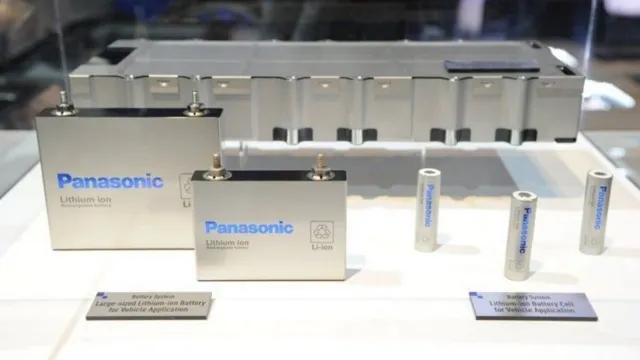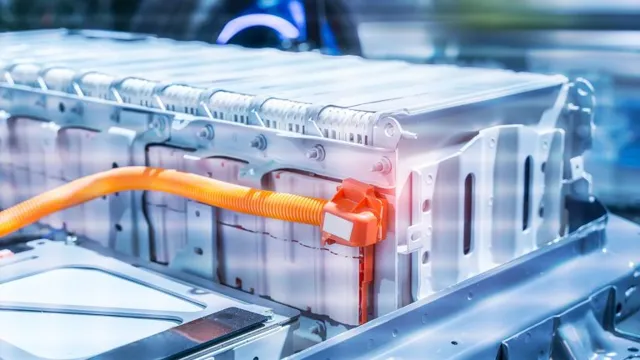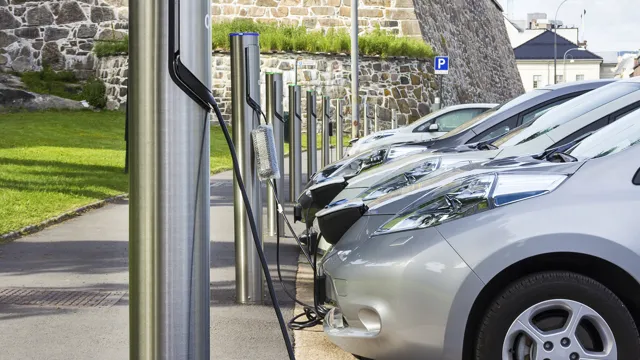Revolutionizing the Future: Minimizing the Carbon Footprint of Electric Car Battery Production
If you’re considering purchasing an electric car, you might be wondering about the environmental impact of the battery production process. After all, producing batteries for electric vehicles is a complex and energy-intensive process. While electric cars have a smaller carbon footprint compared to traditional gasoline-powered cars, the production of their batteries is not without its own environmental consequences.
In this article, we’ll explore the environmental impact of electric car battery production and what steps are being taken to reduce its carbon footprint.
Overview
When it comes to the impact of electric car battery production on the environment, it’s important to consider the carbon footprint. While electric cars themselves have lower emissions than traditional gasoline-powered vehicles, the production of their batteries can be a significant contributor to greenhouse gas emissions. The production of batteries requires a lot of energy and materials, which can result in a higher carbon footprint compared to traditional vehicle manufacturing.
However, efforts are being made to improve the sustainability of electric car battery production, such as using renewable energy sources in the manufacturing process and recycling materials to reduce waste. Overall, while the carbon footprint of electric car battery production is a consideration, it’s important to keep in mind that electric cars still have a lower overall environmental impact than traditional vehicles over their lifetime.
Explanation of Carbon Footprint
Carbon footprint refers to the amount of greenhouse gas emissions an individual, household, or organization generates as they go about their daily activities. These activities can include transportation, electricity consumption, and food choices, among others. The primary greenhouse gases that contribute to climate change are carbon dioxide (CO2), methane (CH4), and nitrous oxide (N2O).
The more greenhouse gases an entity produces, the larger their carbon footprint. Reducing our carbon footprint is crucial for mitigating the effects of climate change and preserving the planet for future generations. By making conscious choices and taking simple steps like reducing energy consumption, using public transportation, and eating locally sourced food, we can all make a positive impact and help combat climate change.
Comparison to Gasoline Cars
When it comes to comparing electric cars and gasoline cars, there are several factors to consider. One of the most significant differences is the way they are powered. Gasoline cars run on fuel that is burned in an internal combustion engine while electric cars use electricity stored in batteries to power an electric motor.
This means that electric cars produce zero emissions while driving, making them a more environmentally friendly option. In terms of maintenance, electric cars have fewer moving parts and therefore require less frequent upkeep. However, the initial cost of purchasing an electric car can be higher than that of a gasoline car, even though the cost of charging an electric car is typically lower than refueling a gasoline car.
Additionally, range anxiety is a concern for some drivers of electric cars, as the distance they can travel on a single charge may be limited. Overall, when it comes to comparing electric cars and gasoline cars, it’s important to consider factors such as environmental impact, maintenance costs, initial cost, and range.
Battery Production Process
Electric car battery production has a significant carbon footprint that must be addressed to transition towards sustainable mobility. The main process used in battery production is the fabrication of the cathode, an essential component that stores energy. Most cathodes are made from materials like cobalt and nickel, which require energy-intensive extraction and refining processes.
To address the carbon footprint and inefficiencies associated with traditional battery production methods, innovative companies are experimenting with new production technologies. For example, companies are exploring different materials like sodium-ion and lithium-sulfur batteries, which require less energy to extract and refine. Additionally, production methods that use renewable energy sources, such as wind and solar power, can further reduce the carbon footprint of battery production.
With an increase in electric vehicle demand, it is essential to prioritize sustainable battery production methods to ensure a carbon-neutral future.
Lifecycle Assessment of Lithium-ion Batteries
Lithium-ion batteries have become an essential part of our lives, powering everything from smartphones to electric cars. However, the production process of these batteries can have a significant environmental impact. The process begins with the extraction of raw materials, such as lithium, cobalt, and nickel, which requires energy-intensive processes that can contribute to GHG emissions.
Once extracted, the materials are transported to a manufacturing facility where they undergo a series of processing steps, including refining, mixing, and coating. These steps again require significant amounts of energy and generate waste and emissions. Finally, the batteries are assembled, packaged, and shipped to their final destination.
Overall, the battery production process is complex and energy-intensive, and it is essential to conduct a lifecycle assessment to understand the overall impact of lithium-ion batteries on the environment and identify strategies for improving their sustainability.
Energy and Resources Used in Production
Battery production is a complex process that involves a number of energy and resource inputs. The production of batteries requires a significant amount of energy, including in the mining and processing of raw materials like lithium and cobalt. This energy usage, in turn, results in carbon emissions and other environmental impacts.
Additionally, the production of batteries relies on other resources, such as water. In order to address these issues, many battery manufacturers are working to reduce the environmental impact of their production processes. This includes investing in renewable energy to power production facilities and exploring alternative materials and processing methods that minimize energy and resource usage.
While there is still much work to be done, progress is being made towards more sustainable battery production methods that will help to support a cleaner and more sustainable energy future.
Environmental Impact of Mining and Extraction
Battery production has become a crucial part of modern technological advancement, powering everything from cars to smartphones. However, this process comes with environmental costs. The mining of metals like cobalt and lithium, which are essential components of batteries, has led to deforestation, soil erosion, and water pollution in places like the Democratic Republic of Congo.
Moreover, manufacturing batteries requires enormous amounts of energy, which often comes from fossil fuels. This energy consumption contributes to greenhouse gas emissions and climate change. Despite these challenges, there are efforts to address the environmental impact of battery production.
Some companies are exploring alternative materials, like sodium-ion and solid-state batteries, that require fewer harmful metals. Additionally, renewable energy sources like solar and wind power can be used to reduce the carbon footprint of battery manufacturing. The key is finding ways to balance technological innovation with sustainable practices to ensure a more environmentally conscious future.
Reducing Carbon Footprint
Electric cars are often touted as more environmentally-friendly options than traditional gasoline-powered vehicles. However, the production of their batteries still has a significant impact on carbon emissions. In fact, electric car battery production carbon footprint can be up to three times more than that of a conventional vehicle’s engine.
This is because the production process involves significant amounts of energy-intensive materials, such as lithium, cobalt, and nickel, which are often mined in areas with lax environmental regulations. Additionally, the energy used in the manufacturing process itself contributes to a large chunk of the carbon footprint. Nonetheless, it’s important to note that using electric cars ultimately results in a lower carbon footprint over the vehicle’s lifetime due to the lack of emissions it produces while driving.
As technology advances and manufacturers find ways to reduce the amount of energy and materials used in the production process, the carbon footprint of electric car batteries will decrease further.
Current and Future Innovations in Battery Production
As the demand for electric vehicles continues to increase, the production of batteries needs to keep up. However, traditional battery production methods have a negative impact on the environment, which calls for innovative and sustainable alternatives. One approach to reducing the industry’s carbon footprint is through recycling lithium-ion batteries.
With around 11 million tons of lithium-ion batteries potentially ending up in landfills by 2030, recycling them can reduce not only environmental harm but also the need for new materials to create batteries. Another promising innovation is the use of renewable energy sources, such as solar or wind power, to fuel the battery manufacturing process. Several battery companies have already taken the initiative to incorporate these methods to reduce emissions and energy consumption in their production facilities.
By investing in sustainable methods, companies can decrease their carbon footprint while continuing to meet the growing demand for batteries.
Sustainability Efforts by Electric Car Manufacturers
As the threat of climate change looms, electric car manufacturers are stepping up their game to reduce their carbon footprint. One way they’re doing this is by using sustainable materials in their vehicles, like recycled plastic and bamboo-based materials. Not only are these materials better for the environment, but they can also reduce the weight of the car, improving its fuel efficiency.
Another initiative taken by electric car manufacturers is to install solar panels on the roofs of their factories to produce clean energy. This, in turn, reduces their dependence on fossil fuels and lowers their carbon emissions. Furthermore, they’re actively promoting the use of renewable energy sources to power their cars and are investing in research to develop better batteries that are more durable and recyclable, ensuring a sustainable future for generations to come.
It’s exciting to see these companies taking responsibility and making efforts to reduce the impact of their products on the environment.
Conclusion
After investigating the electric car battery production carbon footprint, it’s clear that the greenest car isn’t always as clear-cut as we thought. While electric vehicles release fewer emissions when driving, the production of their batteries may actually contribute more carbon to the atmosphere than their gas-guzzling counterparts. However, this doesn’t mean we should give up on electric cars altogether.
Rather, we must continue to innovate and improve the process, finding more sustainable and environmentally-friendly methods of battery production. As the famous saying goes, “Where there’s a will, there’s a way”, and we must strive towards creating a greener future, one lithium-ion battery at a time.”
FAQs
What is the carbon footprint of electric car battery production?
Electric car battery production has a carbon footprint that varies depending on the materials used, manufacturing processes, and location. However, studies show that producing a standard electric vehicle battery generates between 150 and 200 kilograms of carbon dioxide equivalent.
How does the carbon footprint of electric car battery production compare to traditional gasoline car manufacturing?
Traditional gasoline car manufacturing generates an average of 5.6 metric tons of carbon dioxide equivalent, while the production of an electric car battery generates between 150 and 200 kilograms. Therefore, electric car battery production has a significantly lower carbon footprint than traditional gasoline car manufacturing.
Are there any efforts to reduce the carbon footprint of electric car battery production?
Yes, many companies are making efforts to reduce the carbon footprint of electric car battery production. For example, Tesla is working toward using more renewable energy sources and has set a goal of reducing its battery production’s carbon footprint by 10% by 2022. Moreover, many battery manufacturers are exploring new materials and techniques that can reduce the emissions generated during production.
Is it possible for consumers to reduce the carbon footprint of electric car battery production?
Yes, consumers can reduce the carbon footprint of electric car battery production by choosing electric car models that use batteries with lower carbon footprints. Additionally, driving more miles with electric vehicles can offset the initial energy usage and carbon dioxide emissions associated with manufacturing electric vehicle batteries. Finally, properly disposing of old batteries and recycling lithium-ion batteries can also reduce the carbon footprint of electric car battery production.






